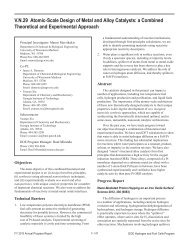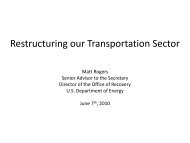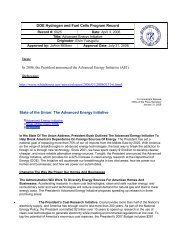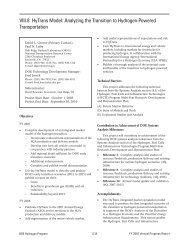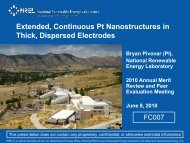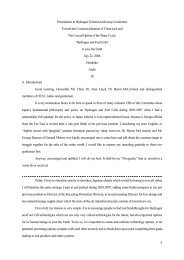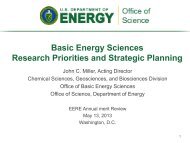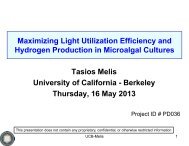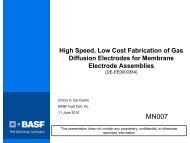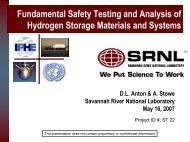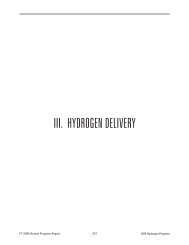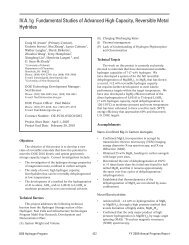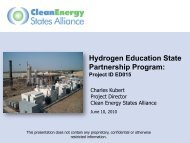Fuel Cell System for Transportation -- 2005 Cost Estimate
Fuel Cell System for Transportation -- 2005 Cost Estimate
Fuel Cell System for Transportation -- 2005 Cost Estimate
Create successful ePaper yourself
Turn your PDF publications into a flip-book with our unique Google optimized e-Paper software.
3. The PEM fuel cell system model per<strong>for</strong>mance was close to state-of-the-art.<br />
The Team believes that the per<strong>for</strong>mance of the PEM fuel cell system model was close to the state-ofthe-art<br />
<strong>for</strong> the cell stack. The purpose of the ANL model is to represent a generic fuel cell system that<br />
could achieve the per<strong>for</strong>mance targets set by DOE. In particular, efficiency at rated power is targeted<br />
by DOE at 50% and efficiency at 25% of rated power is targeted at 60%. At rated power, the ANL<br />
model achieves 47% efficiency and at 25% of rated power, 55% efficiency.<br />
Some BOP components have not been fully demonstrated. Industry reported to the Team that the<br />
compressor-expander was based on data from separate devices and the combined device had not been<br />
demonstrated. The enthalpy wheel was considered bulky and its ultimate reliability was questioned.<br />
Discussions with industry identified alternative technologies that would replace the compressorexpander<br />
and possibly the enthalpy wheel.<br />
Predictably, the ANL model was accepted by some of the fuel cell manufacturers, but not by all. <strong>Fuel</strong><br />
cell integrators have their own fuel cell system designs based on their proprietary technologies. The<br />
configuration of the fuel cell system has a strong influence on the cost analysis, since it will influence<br />
the component per<strong>for</strong>mance specifications (e.g., inlet and outlet pressures, temperatures, flow-rates,<br />
and compositions) and establishes the BOP components. The ANL model may be too focused on one<br />
PEM system or one BOP component manufacturer. Industry representatives suggested alternative<br />
system designs and recommended that a study be undertaken to identify the optimum system <strong>for</strong> PEM<br />
fuel cells.<br />
4. Some cost factors may have been underestimated.<br />
Assembly of the cell stack was not addressed with the same detail as the fuel cell stack components.<br />
The TIAX approach assumes a robotic pick-and-place function that would rapidly assemble the stack.<br />
Further details on the rate of stack assembly (e.g., time to assemble a stack), the number of assembly<br />
lines, and the capital investment <strong>for</strong> these lines are needed to support the assembly costs. Careful<br />
attention to stack assembly is critical to achieving a high acceptance rate and low assembly cost.<br />
Industry recommends future DOE supported cost analyses address this issue.<br />
Industry recognizes that quality control and stack conditioning could contribute significantly to cost<br />
but were excluded from the TIAX analysis at the recommendation of DOE and the Tech Team.<br />
Industry believes quality control is critical and potentially costly to develop and implement into the<br />
manufacturing process. TIAX states that quality control and stack conditioning could add 5% − 50%<br />
to the cost. Narrowing this range will require additional analysis. Stack conditioning is addressed<br />
briefly in the TIAX report, indicating that a two-hour conditioning of the cell stack would cause a<br />
2.5% increase in cell stack cost, whereas a 24-hour conditioning would cause ~ 33% increase.<br />
5. Industry recommends incremental production cost analysis.<br />
The cost analysis <strong>for</strong> the production of 500,000 PEM fuel cell systems provides a gauge by which<br />
DOE can evaluate the progress toward achieving the cost targets <strong>for</strong> automotive PEM fuel cells and,<br />
thus, is valuable. However, fuel cell companies believe progress will be made in incremental steps<br />
with several go/no-go decisions along the way. A real target that industry does consider viable is<br />
manufacturing 10,000 PEM fuel cell systems per year. Incremental increases from 10,000 to 100,000<br />
PEM fuel cell systems are the targets <strong>for</strong> cost analysis that industry believes will be viable.<br />
-6-



